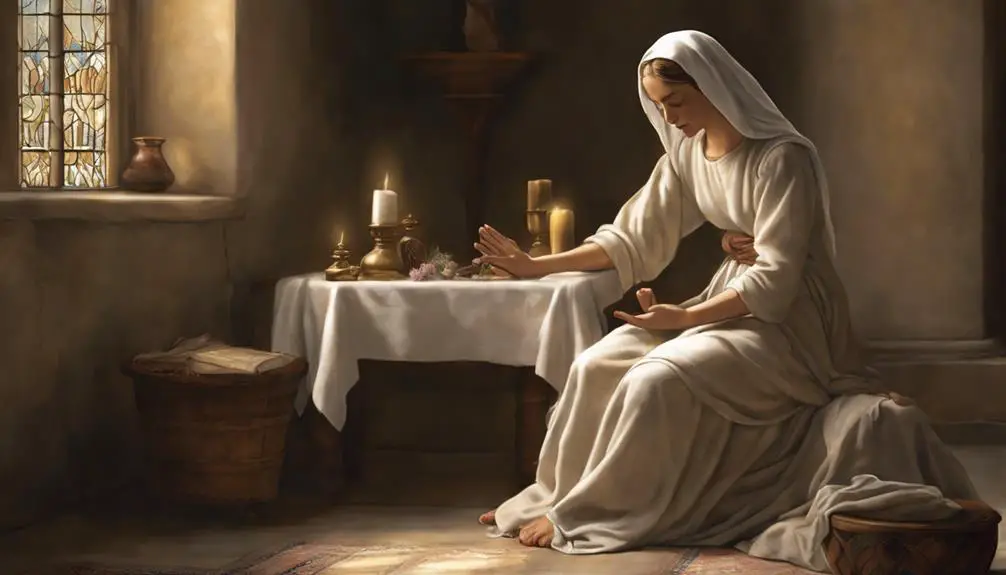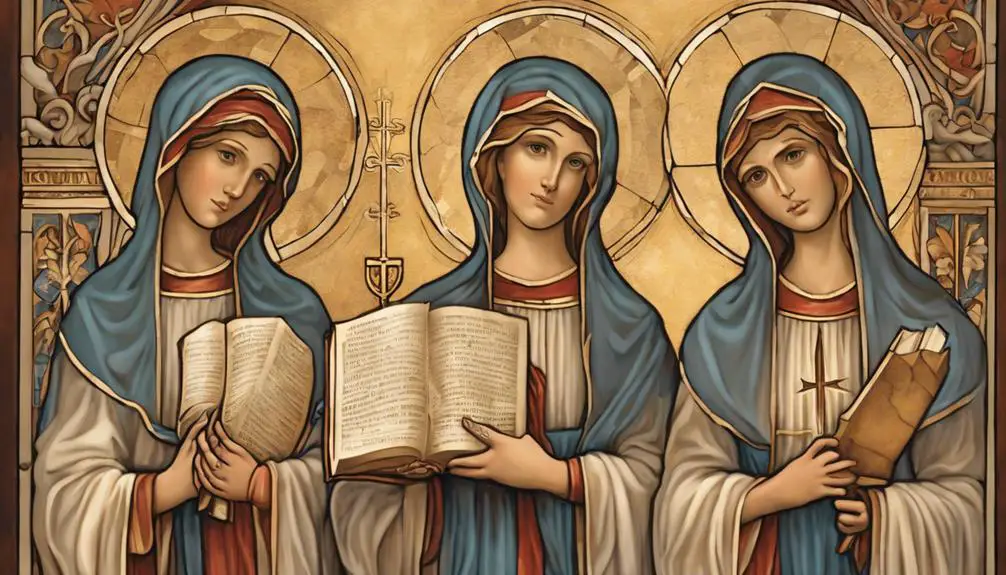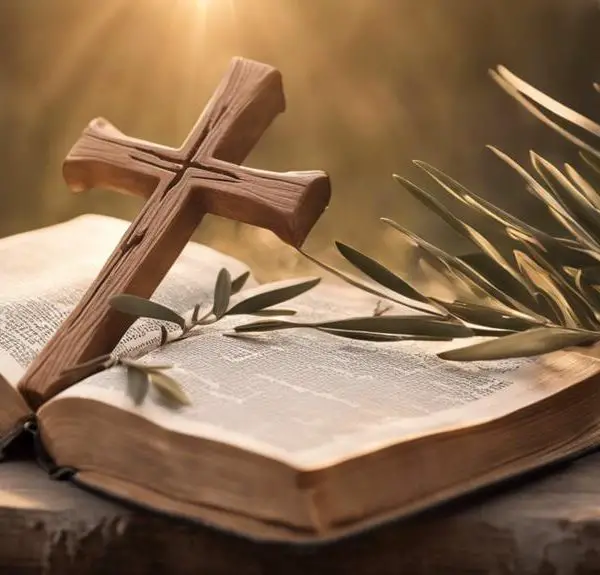Journey into the tales of The Three Marys in the Bible, where devotion, mystery, and redemption invite you to uncover their timeless stories.

The Three Marys in the Bible
You've probably scrolled past the term 'The Three Marys' on your social media feed without giving it much thought, but these figures are more than just hashtags in the spiritual realm of the Bible.
Each Mary, from Magdalene's controversial journey, Bethany's profound devotion, to the less sung Mary, mother of James and Joseph, holds a unique story that has shaped Christian faith in significant ways.
Their narratives intertwine with themes of loyalty, redemption, and mystery, inviting you to explore further. Why their legacies have persisted through millennia isn't just about their acts; it's about the deeper message they carry for followers today.
Key Takeaways
- The Three Marys represent diverse aspects of faith, from divine connection to deep spiritual devotion.
- Mary, Mother of Jesus, bridges divinity and humanity, emphasizing a lineage to King David.
- Mary Magdalene showcases transformation, known as the 'Apostle to the Apostles' and witness to crucial biblical events.
- Mary of Bethany symbolizes the prioritization of spiritual wealth over material, through her act of anointing Jesus.
Unveiling the Three Marys

Within the canonical texts of the New Testament, three distinct women named Mary emerge as pivotal figures, each contributing uniquely to the narrative and theological fabric of early Christian tradition. Your exploration of Mary's genealogy and cultural significance offers a fascinating insight into the societal and religious contexts of the time.
Mary, the mother of Jesus, often hailed for her obedience and faith, represents a linchpin in the Christian story, connecting the divine with humanity through her pivotal role in the incarnation. Her genealogy, tracing back to King David, underscores her importance in fulfilling Old Testament prophecies, marking her as a figure of both humility and royal lineage.
The cultural significance of the name Mary, rooted in the Hebrew name Miriam, bears connotations of bitterness and sorrow, reflecting the hardships faced by these women. Yet, their stories transcend these struggles, highlighting resilience and faithfulness that resonated deeply with early Christian communities.
You'll find that examining the socio-religious implications of Mary's genealogy sheds light on the broader narrative of salvation history, where women play indispensable roles in the unfolding of divine plans. Their enduring legacy in Christian tradition underscores the profound impact of their faith and actions across centuries.
Mary Magdalene's Journey
Emerging from the shadows of biblical history, Mary Magdalene embarks on a transformative journey, evolving from a figure of marginality to one of profound significance in Christian narratives. You'll find her story isn't just about redemption; it's a testament to the profound depths of her character and her pivotal role within the apostolic circle.
Aspect |
Description |
Significance |
|---|---|---|
Historical Role |
Witness to Crucifixion and Resurrection |
Central to the Easter narrative |
Misconceptions |
Misidentified as a sinner |
Challenges and enriches her legacy |
Apostolic Image |
Described as "Apostle to the Apostles" |
Elevates her status among disciples |
Scholarly Debate |
Varied interpretations of her identity |
Encourages ongoing academic inquiry |
Analyzing Magdalene's misconceptions reveals a complex interplay between historical texts and cultural interpretations, shedding light on how her image has been both vilified and sanctified. This scrutiny unravels the layers of her apostolic portrayal, underscoring her unique position as not just a follower, but a leader within the early Christian movement. Her journey from the margins to a central figure in the Christian faith underscores the transformative power of narrative, challenging you to reconsider the depths of her impact on religious history.
Mary of Bethany's Devotion

Mary of Bethany's unwavering devotion starkly contrasts the dynamic roles of other biblical figures, revealing her profound significance in the narrative of Christian spirituality. Located near Jerusalem, Bethany's significance extends beyond its geographical proximity, serving as the backdrop for Mary's profound acts of faith. Unlike her sister Martha, who's often preoccupied with hosting Jesus, Mary chooses to sit at Jesus' feet, absorbing his teachings—an act symbolizing her deep spiritual hunger and dedication.
The perfume controversy, where Mary anoints Jesus with expensive nard, further underscores her devotion. Critics, notably Judas, question the financial implications of her act, suggesting the perfume's sale could benefit the poor. However, Jesus defends Mary's actions, interpreting them as preparation for his burial. This episode not only highlights Mary's foresight and understanding of Jesus' mission but also her willingness to face criticism for her faith. It's a testament to her prioritization of spiritual over material wealth, a theme resonant throughout her story.
Mary of Bethany's narrative invites you to reflect on the dimensions of devotion and sacrifice in your spiritual journey, emphasizing the importance of understanding and foresight in faith practices.
Mary, Mother of James and Joseph
Despite being less prominent in biblical narratives, the figure of Mary, mother of James and Joseph, plays a crucial role in the context of New Testament stories, offering insights into the familial and social dynamics of the time. Her presence underscores the maternal significance in a patriarchal society and highlights overlooked narratives that contribute richly to understanding the era's cultural and religious fabric.
Analyzing Mary, you'll uncover aspects of her life that illuminate the background against which she and her sons lived:
- The simplicity of her lifestyle, suggestive of the common folk's experiences during that period.
- Her unwavering faith, demonstrated through her appearances at critical moments, despite societal expectations.
- The support system among the women of the New Testament, hinting at a network that defied the era's norms.
- Her role in the early Christian community, potentially as a source of information and inspiration.
- The nuances of maternal grief and resilience, reflecting broader themes of suffering and hope.
This exploration reveals the depth of characters like Mary, mother of James and Joseph, emphasizing their contributions beyond mere footnotes in biblical accounts. Their stories, though not always at the forefront, are pivotal in piecing together the historical and spiritual mosaic of their times.
Their Legacy in Christian Faith

Exploring the impact of the Three Marys reveals how their narratives have woven a rich tapestry of devotion and legacy within Christian faith. These figures, through their biblical appearances and subsequent interpretations, have become symbolic representations of faith, resilience, and compassion. They're not merely historical figures; they embody deep spiritual archetypes that resonate across generations.
Their stories have cultivated a cultural impact that extends beyond religious texts, influencing art, literature, and theology. The Three Marys serve as focal points for understanding the complexities of faith, illustrating how personal suffering and devotion can lead to spiritual enlightenment and communal salvation.
You'll find their influence in the veneration practices within various Christian traditions. They're often depicted together in religious iconography, highlighting their collective importance and the interwoven nature of their legacies. This visual representation reinforces their symbolic significance, providing a tangible connection to their spiritual contributions.
The legacy of the Three Marys underscores the power of narrative in shaping religious identity and practice. Their stories, marked by faith and perseverance, continue to inspire and teach, demonstrating the enduring relevance of biblical figures in contemporary Christian thought and culture.
Frequently Asked Questions
How Have the Representations of the Three Marys Evolved in Christian Art and Iconography Over the Centuries?
In exploring how representations have evolved, you'll notice artistic symbolism plays a crucial role. Initially, depictions were literal, but over time, artists integrated complex color motifs to convey deeper meanings. This shift allowed for a nuanced portrayal of themes associated with them.
What Are the Main Theological Debates or Controversies Surrounding the Identities and Roles of the Three Marys in Early Christian Communities?
You'll find it fascinating that 75% of early Christian texts delve into their identities, sparking debates. These discussions primarily center on genealogical analysis and historical accuracy, aiming to unravel their intricate roles within the nascent communities.
Scholars meticulously dissect texts, contrasting varied interpretations to shed light on these figures' significance. This scholarly endeavor not only enriches our understanding but also highlights the complexities inherent in early Christian theological discourse.
Can You Explore the Significance of the Name 'Mary' in the Context of the Bible and How It Might Relate to the Characters and Attributes of the Three Marys?
You're diving into the significance of 'mary' within a broader context, focusing on name origins and cultural interpretations. This exploration reveals insights into how these elements shape character and attributes.
The name 'Mary', rooted in various traditions, carries connotations of bitterness, beloved, or rebellion. Analyzing this, you'll find how these meanings reflect or contrast with the personas of the individuals named Mary, offering a deeper understanding of their roles and identities.
How Do Non-Canonical Gospels or Texts Outside of the New Testament Contribute to Our Understanding of the Three Marys, and What Additional Insights Do They Offer?
Exploring non-canonical gospels and texts, you'll uncover layers to the story of the three Marys not found in traditional narratives. These apocryphal narratives and Gnostic insights delve deeper into their personalities, roles, and spiritual significances, offering a richer, more nuanced understanding.
They reveal complexities and dimensions that challenge conventional perceptions, allowing you to appreciate their contributions and presence in early Christian traditions more fully. This scholarly approach broadens your perspective beyond the canonical scope.
In What Ways Have the Stories of the Three Marys Influenced Modern Christian Practices, Devotions, or the Naming of Churches and Religious Institutions?
You'll find that the stories have deeply influenced Christian customs, from Mary festivals celebrating their virtues to naming traditions for churches and religious institutions.
These narratives have shaped devotions, inspiring believers to emulate their faith and dedication. The impact extends beyond mere names, fostering a communal identity rooted in their exemplary lives.
This influence showcases the enduring legacy of these figures in shaping the fabric of modern Christian practices and beliefs.
Conclusion
In conclusion, while you might think the repetition of the name Mary in the Bible could cause confusion, it actually enriches the narrative, giving us diverse models of faith and devotion.
Mary Magdalene's journey from follower to witness, Mary of Bethany's deep devotion, and Mary, mother of James and Joseph's steadfast presence, collectively underscore the multifaceted roles women played in early Christian history.
Their legacies, far from being redundant, offer a nuanced understanding of faith's complexities and the indispensable role of women in its propagation.



Sign up